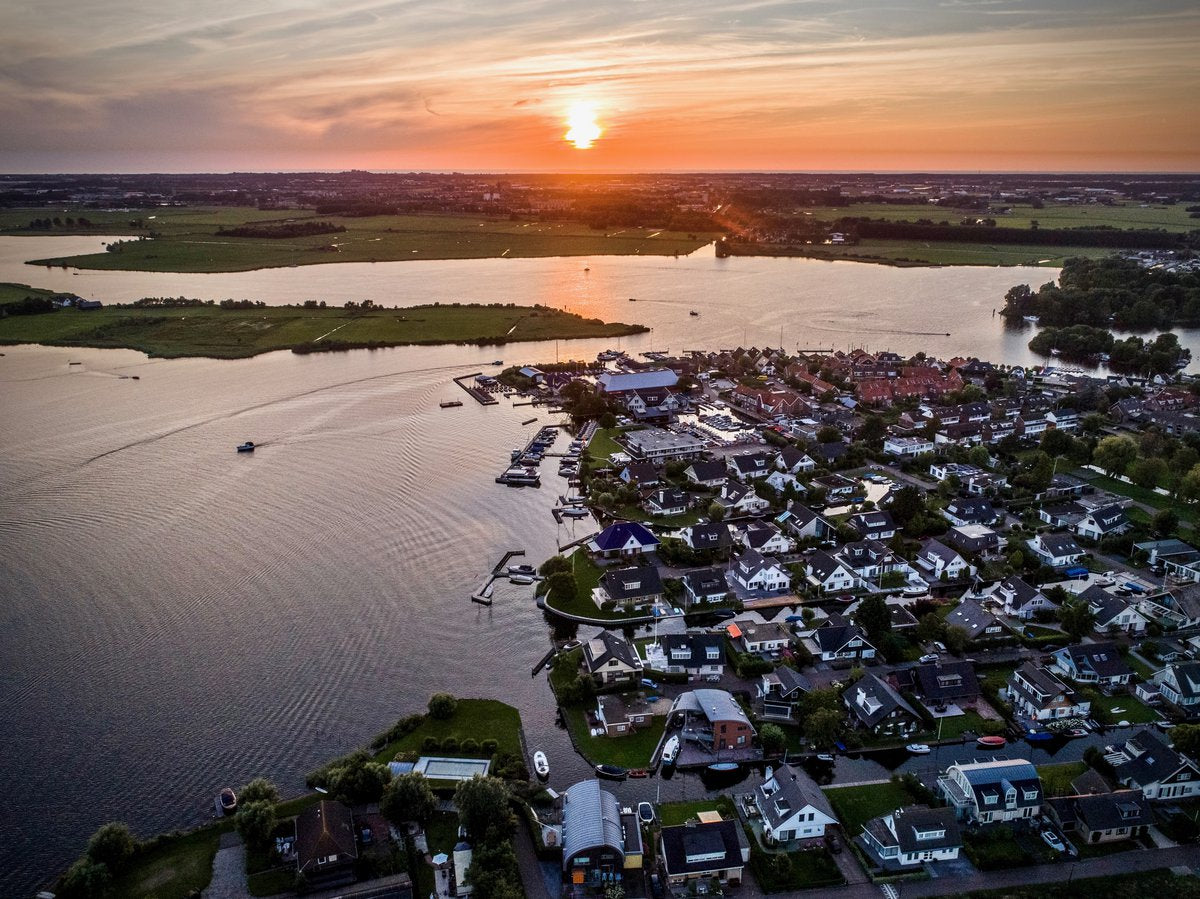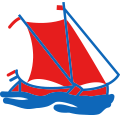
Title
Sights Kaag
Tante Kee, Julianalaan 14
A Zwetsloot family lived here in the past and had a grocery store where distilled spirits were also sold. Through a special sequence of events, the family also started a pancake restaurant in the building, which grew into a full restaurant. This generated so much activity that the shop was closed. The Zwetsloot family left Kaag several decades ago and their restaurant was continued by various operators. Tante Kee is currently managed by Raymond Reeb and Kim Edwards and they fly the flag of Jeunes Restaurateurs d' Europe.Before the renovation and extension of the kitchen, a facade brick was visible in the north wall of the former shop. This is now hidden from view due to the expansion, but is still present. The facade stone "De Meermin" comes from the facade of a daily allowance house of farmer Nell [Julianalaan 12]. He sold the house to Mr J.H.C. Voorhoeve from The Hague who had the artwork, made by Pam G. Rueter, bricked into the facade. Aunt Kee probably acquired "De Meermin" when the house was demolished. We have to continue with a photo and of course the beautifully restored and expanded building, which was further embellished this year with a renovated terrace and scaffolding on the water side.
Julianalaan 18
After Aunt Kee follows the old farm, which is used as a house, where a Loogman family once had its vegetable business. Also from the water, this building, together with that of the neighbors, Tante Kee and number 20-22plus, provides a view of the Dutch Reformed Church, one of the beautiful parts of Kaag.
Dutch Reformed Church, Julianalaan 7
Opposite the church district - the harbor that opens onto the Gravenwater - is the Dutch Reformed church. This church has been here since 1873. Before the Reformation, there was already a chapel dedicated to Mary Magdala, which belonged to the Roman Catholic Church. parish of Sassenheim.
The Protestant community on Kaag is older than the current church and this also applies to several valuable objects that date from the former chapel. There is a silver supper set from 1654, beautiful tin work and the copper lectern from the 18th century, a Staten Bible that was printed in 1729 by Pieter and Jacob Keur in Dordrecht and a cantor's Bible from 1768, from the Amstel Church in Amsterdam. In the church there are two brass crowns, also from the 18th century. One of them has three shields with the coat of arms of Wassenaar, a boater under sail, with flags and the name Johannes Huybertse van Daale on it. The bell, cast by P. Hemony in Amsterdam in 1675, and the clock, which has since been restored, are also older than the church itself.
The bell was removed from the tower by the occupying forces on April 28, 1943, to serve, like many other examples, as raw material for the Nazi war industry. However, the skipper who provided the transport sank his ship on the IJsselmeer. After the war, the ship and cargo were salvaged and in 1946 the bell hung back in the tower.
The small but active community develops various activities. A service is held every Sunday at 10am. If you would like personal contact with the pastor or members of the church council about the cemetery, use of the buildings or otherwise, the website www.protestantsegemeentekaag.nl can provide you with further information.
Julianalaan 20-22
Once again a very well maintained building. This time no replica but a thoroughly restored house. In the past, a professor Visser lived there with his family. He restored the then two houses in the old style and the current residents carried out the restoration and maintained the two numbers. A jewel for Kaag, both from the water and from the road.
Julianalaan 26
The last professional fisherman on the island lives here: Mr J.A.van Nieuwkoop. This house used to be inhabited by two families and there was also a post office here. This later went to the Buitenkaag, but it has also been removed there. We can only guess at the year of construction of this house, but it is old. The oak that has grown slightly over the road also has an impressive age. Although collisions with various vehicles have damaged this sturdy oak, it has always emerged as a winner. In an earlier version I wrote that the facade of the picturesque shed leaned forward in a worrying manner. We now see that the top part has fallen from the facade and that the ridge of the roof must be supported and the tiles have been removed from the roof to prevent collapse. It is hoped that the new owner will also make this building and associated shed an attractive part of the Kaag, as he did with De Stal on the Kaag (number 13a).
"Vogelskamp", formerly "Lombok"
The written history of this island dates back to 1525. It belonged to the Abbey of Rijnsburg and was leased as a forest plot until at least 1895. So for wood production. Later owners farmed on the island. Hay for the cattle was delivered by barge. From that time there is a postcard on which the island bore the name "Lombok". Currently it only has a residential purpose and sloops and sailboats are moored there.
On old topographical maps the island is connected to Kaag by a bridge. However, the bridge disappeared at some point and nowadays residents use a pedestrian ferry that is 'turned' by hand to get to Kaag. Vogelskamp belonged to the municipality of Warmond, which was merged into the municipality of Teylingen on January 1, 2008 through a merger with Voorhout and Sassenheim. Kaag has been part of the municipality of Alkemade for many years. However, with effect from January 1, 2009, the municipality of Alkemade also ceased to exist. After the merger with Jacobswoude, Kaag is one of the eleven villages that together form the merged municipality of Kaag and Braassem.
Kaag Island "eye of the needle"
The Julianalaan is narrow and legally limited to vehicles with a maximum width of 2.20 m. The bottle neck is located between Julianalaan 17 and Julianalaan 30 ["The old sail maker"] where Brugt de Ruiter once lived. A Zwetsloot family used to live at 17. In the fifties later, Adriaan Elstgeest, who married his daughter Cor, moved in with his mother-in-law. The old Mrs. Zwetsloot has died and Adriaan Elstgeest and his wife left after the division of the Akerboom and Van Lent shipyard, with Hein Akerboom to Lisse. Adriaan and Cor have now also passed away.
Julianalaan 19, Hotel Orion
After thorough restoration and substantial expansion, the budget hotel Orion is located in the former youth hostel. This hotel has twenty-five rooms and modern facilities to accommodate conferences, congresses and seminars. From the parking lot you have a beautiful view of the polder and the Kagermolen at the Keverhaven. The banks of the Keverhaven underwent major maintenance in 2011. The harbor offers yachts and boats free mooring options.
"De Oude School", Julianalaan 36
This is indeed where the old village school stood. The current building is a very successful replica. The original school building had no dormer windows or blinds, which were installed later. The current residents have adjusted the color of the shutters in a historically appropriate manner. A few years ago they were still red hourglasses on a white surface. Behind the three windows there were two classes during the school phase and behind the house was a playground. From the road you have a nice view of the lake over the entrance and the garden.
Julianalaan 25
The cute house of the Biemond family was originally a so-called daily allowance house from the beginning of the 19th century. Farmer Nell's permanent servants [Julianalaan 13] used to live here. There once was a similar house on the site of "Zorg en Vlijt" [Julianalaan 21], which was inhabited by the Van Nieuwkoop family. However, this is where modernization has struck. ...
Julianalaan 42
Kaag's night watchman used to live here. This Vlugt family also had some cattle. Where the trees stood, on the left against the water, was a haystack. Vlugt also sold petroleum. The last permanent resident was a well-known Kager, Karel Bruns. The house is included in almost every photo series about Kaag and is therefore not missing from this list. It is a beautiful spot that offers all the pleasures of the low shore when there is a strong (south)westerly wind. The house was demolished in May 2024 and will make way for something new.
Van Ruiten Dairy Farm, Julianalaan 29
A piece of characteristic Kaag, the farm of the Van Ruiten family. With the thatched roof, which was renovated a few years ago, this old farmhouse is in good condition again. The family prepares cheese and butter themselves during the time that the cows are out in the meadow every day. In winter, when the animals are in the modern stable, no cheese or butter is made. The family scores well at the annual farmer's cheese inspections, with its Leiden cheese, a recognized regional product.
De Zegen (The Blessing)
In the Dirk van Nieuwkoopplantsoentje [corner Julianalaan-Beatrixlaan] there is a monument with the inscription: "HY WERKTE MET ZEGEN" (HE WORKED WITH BLESSING). It depicts a seine [type of fishing net] with which Dirk van Nieuwkoop and his family members fished. It was made by Mr. de Baat Jr., a son of Master de Baat, a now deceased, well-known schoolmaster from Kaag. Dirk died on July 23, 1965 and in memory of him, the municipality of Alkemade created the small park here in the middle of Kaag. Dirk was actively involved in all kinds of village activities. Note. The municipality of Kaag en Braassem has responded to the request of a local entrepreneur to be allowed to use a substantial part of the park as a parking lot. It is clear that this will not beautify this lovely village scene.
"The old bakery", Julianalaan 52
Aart van Asselt had a bread bakery here in the past. Of the well-maintained building, only the fanlight of the front door is a reminder of the noble baking craft. Kagerwerf and the village square. Not a real attraction, but worth mentioning: the Kaagse playground. With the support of the municipality of Alkemade and local sponsors, a playground and a village square were built here at the end of the eighties by the then village council, led by this writer. The playground scores particularly high with our young guests and residents and there are benches on the square so that you can relax. The Kaag coat of arms was re-imagined here by a paving contractor in 2012, after the first, more subtle and, in my opinion, more beautiful version was removed due to filling work. The lime trees give the whole a cozy experience.
"The White House", Julianalaan 37
The Loogman family has lived here for many years. Piet Loogman currently lives in this beautiful building. Until a few years ago, he and his now deceased brother Jan and sister Nel ran a shop where groceries, bread and dairy products, among other things, were sold. Before the Loogman family moved here, Meester de Groot lived at this address.
